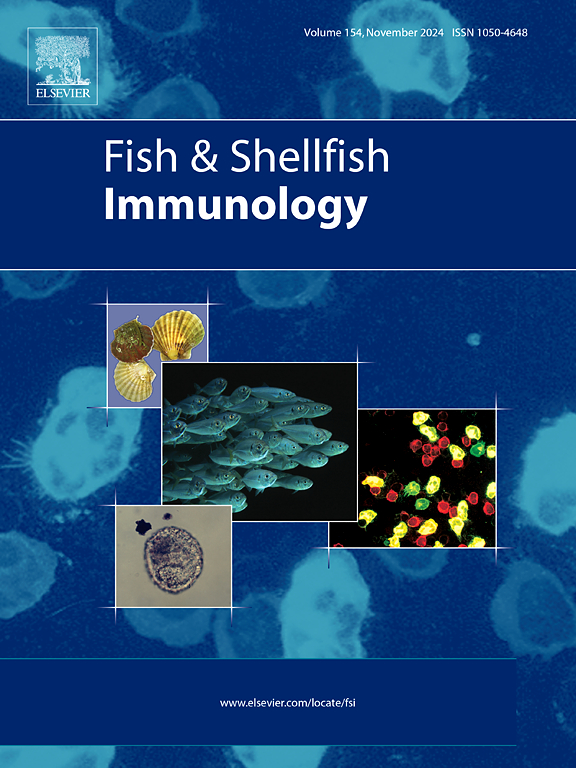Integrated metabolome-SNP-gut microbiome analysis deciphers the molecular basis of EHP resistance in Penaeus vannamei
IF 3.9
2区 农林科学
Q1 FISHERIES
引用次数: 0
Abstract
Enterocytozoon hepatopenaei (EHP) has emerged as a highly virulent pathogen in shrimp aquaculture, yet the molecular determinants governing host resistance remain incompletely characterized. This study employed an integrated multi-omics strategy (metabolome, transcriptome, and microbiome) to elucidate the molecular basis of EHP resistance in Penaeus vannamei. Comparative metabolomic profiling of EHP-resistant (R4029) and susceptible (S4104) family lines identified 1614 metabolites, primarily organic acids (35.07 %) and lipids (21.56 %). Orthogonal partial least squares discriminant analysis (OPLS-DA) revealed significant intergroup metabolic differentiation (Q2 > 0.9), with 428 and 388 metabolites exhibiting differential abundance (variable importance in projection |VIP| > 1, false discovery rate-adjusted P < 0.05) identified in uninfected (S4104-D vs R4029-D) and infected (S4104-G vs R4029-G) states, respectively. Joint KEGG pathway enrichment analysis of transcriptomic and metabolomic datasets identified 661 commonly dysregulated genes (DEGs) and 205 differentially abundant metabolites (DEMs), with glycine/serine/threonine metabolism (ko00260) and cysteine/methionine metabolism (ko00270) emerging as pivotal pathways underpining resistance. Integrative multi-omics analysis using O2PLS modelling revealed robust correlations between 12 key DEGs and 15 DEMs, thereby prioritizing macrophage mannose receptor 1 (MRC1) and betaine-homocysteine S-methyltransferase (BHMT) as principal candidate genes. Single-nucleotide polymorphism (SNP) screening identified seven BHMT sequence variants, including three variants significantly associated with resistance (BHMT-8159 in intron 3; BHMT-12167 and BHMT-12710 in exonic regions), as well as fourteen MRC1 variants, of which six showed significant associations (P < 0.05), most notably the missense mutation MRC1-759 (A > C) inducing a Thr253Pro substitution (full-length MRC1 sequence) that alters protein secondary structure. Gut microbiome characterization demonstrated elevated α-diversity (P < 0.05) and enhanced community stability in resistant shrimp, with selective enrichment of putatively beneficial taxa (Photobacterium, Ralstonia). Collectively, these findings suggest that EHP resistance is mediated by coordinated transcriptional and metabolic reprogramming, functionally consequential genetic polymorphisms, and stable microbial community dynamics, thereby establishing a multi-omics framework for the selective breeding of EHP-resistant shrimp.
综合代谢组- snp -肠道微生物组分析揭示了凡纳滨对虾EHP抗性的分子基础
肝原肠胞虫(EHP)已成为虾类养殖中一种高毒力病原体,但控制宿主耐药性的分子决定因素尚未完全确定。本研究采用综合多组学策略(代谢组、转录组和微生物组)来阐明凡纳滨对虾EHP抗性的分子基础。ehp抗性(R4029)和易感(S4104)家族品系的代谢组学比较分析鉴定出1614种代谢物,主要是有机酸(35.07%)和脂质(21.56%)。正交偏最小二乘判别分析(OPLS-DA)显示了显著的组间代谢分化(Q2 > 0.9),在未感染(s494 - d vs R4029-D)和感染(s494 - g vs R4029-G)状态下,分别鉴定出428和388种代谢物具有不同的丰度(在预测|VIP| >; 1中的变量重要性,假发现率调整后的P <; 0.05)。转录组学和代谢组学数据集的联合KEGG途径富集分析鉴定出661个常见失调基因(deg)和205个差异丰富的代谢物(DEMs),其中甘氨酸/丝氨酸/苏氨酸代谢(ko00260)和半胱氨酸/蛋氨酸代谢(ko00270)成为支撑耐药性的关键途径。使用O2PLS模型的综合多组学分析显示,12个关键deg和15个dem之间存在强大的相关性,因此优先考虑巨噬细胞甘露糖受体1 (MRC1)和甜菜碱-同型半胱氨酸s -甲基转移酶(BHMT)作为主要候选基因。单核苷酸多态性(SNP)筛选鉴定出7个BHMT序列变异,包括3个与耐药显著相关的变异(内含子3的BHMT-8159;外显子区域的BHMT-12167和BHMT-12710),以及14个MRC1变异,其中6个与耐药显著相关(P < 0.05),最显著的是错配突变MRC1-759 (A >; C)诱导Thr253Pro取代(全长MRC1序列),改变蛋白质的次级结构。肠道微生物组特征表明,抗性对虾的α-多样性升高(P < 0.05),群落稳定性增强,并选择性地富集了假定的有益类群(光杆菌,Ralstonia)。总之,这些研究结果表明,EHP抗性是由协调的转录和代谢重编程、功能相应的遗传多态性和稳定的微生物群落动态介导的,从而为EHP抗性对虾的选择性育种建立了多组学框架。
本文章由计算机程序翻译,如有差异,请以英文原文为准。
求助全文
约1分钟内获得全文
求助全文
来源期刊

Fish & shellfish immunology
农林科学-海洋与淡水生物学
CiteScore
7.50
自引率
19.10%
发文量
750
审稿时长
68 days
期刊介绍:
Fish and Shellfish Immunology rapidly publishes high-quality, peer-refereed contributions in the expanding fields of fish and shellfish immunology. It presents studies on the basic mechanisms of both the specific and non-specific defense systems, the cells, tissues, and humoral factors involved, their dependence on environmental and intrinsic factors, response to pathogens, response to vaccination, and applied studies on the development of specific vaccines for use in the aquaculture industry.
 求助内容:
求助内容: 应助结果提醒方式:
应助结果提醒方式:


